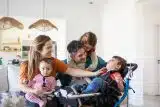Why Pre-Writing Skills Matter and How to Foster Them in Young Children
Kids
 Posted by: Rebecca Bazzoni 9 months ago
Posted by: Rebecca Bazzoni 9 months ago
Pre-writing skills are fundamental abilities that children develop before they begin formal writing. These skills focus on developing fine motor control, hand-eye coordination, and the foundational abilities needed to hold a writing instrument and produce written marks.

Let’s explore the top 10 pre-writing skills to foster in young children and activities you can do with your child to help them develop these essential skills.
1. Fine Motor Skills
Fine motor skills involve the precise movement of small muscles in the hands and fingers. Enhancing fine motor skills prepares children for writing by strengthening their hand and finger muscles.
Activities such as finger painting, cutting with scissors, manipulating small objects, threading beads, and using playdough can help your child develop fine motor skills.
2. Hand-Eye Coordination
Hand-eye coordination refers to the ability to coordinate input from the eyes with hand movements.
Practicing activities that involve tracking objects, such as catching or throwing a ball, using building blocks, and completing puzzles, can help your child develop this essential skill.
3. Pincer Grip
The pincer grip is the ability to hold objects between the thumb and index finger. This grip is crucial for holding and controlling writing tools.
Encourage activities with your child that promote the pincer grip, such as using small tongs or clothespins, picking up small objects with their fingers, and placing objects into containers.
4. Hand Dominance
Developing a dominant hand preference is important for efficient writing.
Although hand dominance naturally emerges as children grow, you can encourage activities that promote bilateral hand use, such as drawing or coloring with both hands, playing catch, or using manipulative toys with both hands.
5. Crossing the Midline
Crossing the midline is the ability to reach across the body’s midsection with one hand and coordinate movements on the opposite side. This skill is essential for writing and overall coordination as your child grows.
To help them develop this pre-writing skill, try to incorporate activities that involve crossing the midline, such as reaching for objects diagonally, drawing large shapes or letters in the air, or playing games that require crossing the midline, such as Simon Says, marching games, or yoga poses.
6. Shape and Line Formation
Encourage your child to practice making shapes and lines using various tools such as crayons, markers, or pencils.
Direct them to draw a variety of shapes and lines, such as straight lines, curves, circles, squares, and triangles.
These activities help develop their hand control, spatial awareness, and the ability to replicate shapes and lines.
7. Tracing and Copying
Provide tracing worksheets or drawing shapes and letters for your child to practice tracing or copying.
This activity helps improve hand-eye coordination, fine motor control, and letter formation while familiarizing children with letter shapes.
You can find a variety of free worksheets online or purchase pre-school activity books that include tracing and copying activities.
8. Sensory Play
Engage your child in sensory play experiences that involve finger painting, drawing with sand or shaving cream, or using textured materials to create marks.
These activities provide tactile feedback, stimulate the senses, and enhance fine motor skills.
9. Playdough and Manipulative Activities
Encourage children to manipulate playdough and similar compounds like clay and slime, which can help them build hand strength and dexterity.
Offer opportunities to roll, shape, pinch, and cut playdough, and use manipulative toys like building blocks and interlocking puzzles.
10. Vertical and Horizontal Lines
Help your child practice drawing vertical and horizontal lines, as these are foundational strokes for forming letters.
Allow them to trace the lines or use visual aids to help them understand the direction and movements required as they begin to learn how to write and form letters.
Remember, pre-writing skills develop gradually, and each child progresses at their own pace.
When you actively engage children in a range of activities that promote fine motor control, hand-eye coordination, and manipulation skills, you provide them with a solid foundation for future writing abilities.
Categories:
You May Be Interested In:





